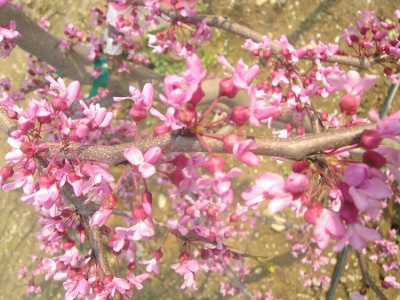Eastern Redbud Tree
Category: Deciduous Trees

Facts about Eastern Redbud Tree, "Scientific name for Eastern Redbud Tree is Cercis canadensis". The Eastern Redbud or Cercis Canadensis is a small deciduous tree native to North America. The species genus of Cercis comes from the Greek word kerkis. Kerkis means a weaver’s shuttle, which its seed pods resemble.
Eastern Redbud Tree grows as far south as Florida and as far north as Ontario. Eastern Redbud Tree is the state tree of Oklahoma, though it may have originated in Missouri. The Eastern Redbud Trees are placed in small groups or located as stand alone trees in gardens, along streets and in woodland margins.
The Eastern Redbud Tree is a member of the Fabacea family. It grows up to thirty feet tall in zones four through eight. It has a twenty five to thirty five foot spread. Eastern Redbud Tree grows in areas with partial shade to full sun.
The Eastern Redbud Tree puts out its namesake pink and purple pea-like blooms in March or April. They bloom later at the northern end of their range. The flowers form in clusters of four to ten flowers. They continue to bloom through April, when the tree then puts out its two to four inch long seed pods. Eastern Redbud Tree has lovely leaves in the fall, producing yellow and blue green heart-shaped leaves with a papery texture. The Eastern Redbud Tree turn yellow before falling off. The bark is consistently dark and smooth.
A Full grown Eastern Redbud Tree can absorb as much as 48 pounds (21.77 kg) of carbon dioxide a year. The same tree could also produce enough oxygen in a day for two people. In a single day, a large Eastern Redbud Tree can drink up to 100 gallons (378.5 liter) of water from the ground and discharge it into the air.
The Eastern Redbud Tree needs medium levels of watering. It grows best in well-drained soils. Do not plant it in poorly drained soils.
Eastern Redbud Tree growth is referred to as Meristem (The undifferentiated embryonic plant tissue from which new cells are created, as that at the tip of a root or stem). This tissue can be found at the tips of shoots and leaves. Inside the stem growth in thickness occurs at the vascular cambium.
Eastern Redbud Trees make their own food from sunlight, carbon dioxide, water, and nutrients from the soil.
The Eastern Redbud Tree attracts butterflies, blueberry bees and carpenter bees and can tolerate deer. Eastern Redbud Tree does not tolerate transplanting once it is larger than a seedling. This species suffers from cankers. It is susceptible to verticillium wilt, mildew, blight and leaf spots. It is sometimes attacked by Japanese beetles, leaf hoppers, borers, scale and tree hoppers. Gardeners can improve the Eastern Redbud Tree’s health with regular pruning of dead branches, proper watering and application of fertilizer.
You can tell a Eastern Redbud Trees age by the number of growth rings. Growth rings size shows what kind of conditions accrued that year, the temperature and if it was a dry or wet year.
Bark of the Eastern Redbud Tree protects it from the elements and is made up of dead cells.
Eastern Redbud Tree roots usually grow two to three times the width of the tree branches. The ideal time to fertilize your Eastern Redbud Tree is in late fall or early spring. If you want to transplant a tree do it in fall, this is ideal for most trees.

 Back To Category Deciduous Trees
Back To Category Deciduous Trees